Vegetable
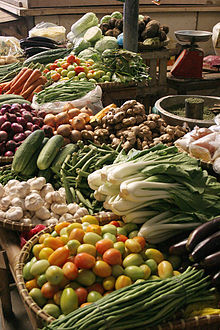
In everyday usage, a vegetable is any part of a plant that is consumed by humans as food as part of a savoury course or meal. The term "vegetable" is somewhat arbitrary, and largely defined through culinary and cultural tradition. It normally excludes other main types of plant food, fruits, nuts and cereal grains but includes seeds such as pulses. The original meaning of the word vegetable, still used in biology, was to describe all types of plant, as in the terms "vegetable kingdom" and "vegetable matter".
Originally, vegetables were collected from the wild by hunter-gatherers and entered cultivation in several parts of the world, probably during the period 10,000 BC to 7,000 BC, when a new agricultural way of life developed. At first plants which grew locally would have been cultivated, but as time went on, trade brought exotic crops from elsewhere to add to domestic types. Nowadays, most vegetables are grown all over the world as climate permits, and crops may be cultivated in protected environments in less suitable locations. China is the largest producer of vegetables, and global trade in agricultural products allows consumers to purchase vegetables grown in faraway countries. The scale of production varies from subsistence farmers supplying the needs of their family for food, to agribusinesses with vast acreages of single product crops. Depending on the type of vegetable concerned, harvesting the crop is followed by grading, storing, processing and marketing.
Vegetables can be eaten either raw or cooked and play an important role in human nutrition, being mostly low in fat and carbohydrates, but high in vitamins, minerals and fibre. Many governments encourage their citizens to consume plenty of fruit and vegetables, five or more portions a day often being recommended.
Etymology

The word vegetable was first recorded in English in the early 15th century. It comes from Old French,[1] and was originally applied to all plants; the word is still used in this sense in biological contexts.[2] It derives from Medieval Latin vegetabilis "growing, flourishing" (i.e. of a plant), a semantic change from a Late Latin meaning "to be enlivening, quickening".[1] Use of the word for a person who has an uneventful life originated in 1921 while its use for someone totally lacking in mental and physical capacity dates from 1976.[1]
The meaning of "vegetable" as a "plant grown for food" was not established until the 18th century.[3] In 1767, the word was specifically used to mean a "plant cultivated for food, an edible herb or root". The year 1955 noted the first use of the shortened, slang term "veggie".[1]
As an adjective, the word vegetable is used in scientific and technical contexts with a different and much broader meaning, namely of "related to plants" in general, edible or not as in vegetable matter, vegetable kingdom, vegetable origin, etc.[2]
Terminology

Defining a "vegetable" is hard because so many different parts of a plant are consumed as food; roots, tubers, bulbs, corms, stems, leaf stems, leaf sheaths, leaves, buds, flowers, fruits and seeds. The broadest definition is the word's use adjectivally to mean "matter of plant origin" to distinguish it from "animal", meaning "matter of animal origin". More specifically, a vegetable may be defined as "any plant, part of which is used for food",[4] a secondary meaning then being "the edible part of such a plant".[4] A more precise definition is "any plant part consumed for food that is not a fruit or seed, but including mature fruits that are eaten as part of a main meal".[5][6] Falling outside these definitions are mushrooms and other edible fungi which, although not parts of plants, are often treated as vegetables.[7]
In everyday language, the words "fruit" and "vegetable" are mutually exclusive. "Fruit" has a precise botanical meaning, being part of a plant that developed from the ovary of a flowering plant. This is considerably different from the word's culinary meaning. While peaches, plums, and oranges are "fruit" in both senses, many items commonly called "vegetables", such as eggplants, bell peppers and tomatoes, are botanically fruits. The question of whether the tomato is a fruit or a vegetable found its way into the United States Supreme Court in 1893. The court ruled unanimously in Nix v. Hedden that a tomato is correctly identified as, and thus taxed as, a vegetable, for the purposes of the Tariff of 1883 on imported produce. The court did acknowledge, however, that, botanically speaking, a tomato is a fruit.[8]
History
Before the advent of agriculture, humans were hunter-gatherers. They foraged for edible fruit, nuts, stems, leaves, corms and tubers, scavenged for dead animals and hunted living ones for food.[9]Forest gardening in a tropical jungle clearing is thought to be the first example of agriculture; useful plant species were identified and encouraged to grow while undesirable species were removed. Plant breeding through the selection of strains with desirable traits such as large fruit and vigorous growth soon followed.[10] While the first evidence for the domestication of grasses such as wheat and barley has been found in the Fertile Crescent in the Middle East, it is likely that various peoples around the world started growing crops in the period 10,000 BC to 7,000 BC.[11]Subsistence agriculture continues to this day, with many rural farmers in Africa, Asia, South America and elsewhere using their plots of land to produce enough food for their families, while any surplus produce is used for exchange against other goods.[12]
Throughout recorded history, the rich have been able to afford a varied diet including meat, vegetables and fruit, but for poor people, meat was a luxury and the food they ate was very dull, typically comprising mainly some staple product made from rice, rye, barley, wheat, millet or maize. The addition of vegetable matter provided some variety to the diet. The staple diet of the Aztecs in Central America was maize and they cultivated tomatoes, avocados, beans, peppers, pumpkins, squashes, peanuts and amaranth seeds to supplement their tortillas and porridge. In Peru, the Incas subsisted on maize in the lowlands and potatoes at higher altitudes. They used seeds from quinoa, supplementing their diet with peppers, tomatoes and avocados.[13]
In Ancient China, rice was the staple crop in the south and wheat in the north, the latter made into dumplings, noodles and pancakes. Vegetables used to accompany these included yams, soya beans, broad beans, turnips, spring onions and garlic. The diet of the ancient Egyptians was based on bread, often contaminated with sand which wore away their teeth. Meat was a luxury but fish was more plentiful. These were accompanied by a range of vegetables including marrows, broad beans, lentils, onions, leeks, garlic, radishes and lettuces.[13]
The mainstay of the Ancient Greek diet was bread, and this was accompanied by goat's cheese, olives, figs, fish and occasionally meat. The vegetables grown included onions, garlic, cabbages, melons and lentils.[14] In Ancient Rome a thick porridge was made of emmer wheat or beans, accompanied by green vegetables but little meat, and fish was not esteemed. The Romans grew broad beans, peas, onions and turnips and ate the leaves of beets rather than their roots.[15]
Some common vegetables
| Some common vegetables | ||||
|---|---|---|---|---|
| Image | Description | Parts used | Origin | Related cultivars |
 | Cabbage Brassica oleracea | Leaves, axillary buds, stems, flowerheads | Europe | Cabbage, red cabbage Savoy cabbage, kale Brussels sprouts, kohlrabi, cauliflower, broccoli Chinese broccoli |
 | Turnip Brassica rapa | Tubers, leaves | Asia | Turnip, rutabaga (swede) Chinese cabbage napa cabbage bok choy, collard greens |
 | Radish Raphanus sativus | Roots, leaves, seed pods, seed oil, sprouting | Southeastern Asia | Radish daikon seedpod varieties |
 | Carrot Daucus carota | Root tubers | Persia | Carrot |
 | Parsnip Pastinaca sativa | Root tubers | Eurasia | Parsnip |
 | Beetroot Beta vulgaris | Tubers, leaves | Europe, Near East and India | Beetroot sea beet Swiss chard sugar beet |
 | Lettuce Lactuca sativa | Leaves, stems, seed oil | Egypt | Lettuce celtuce |
 | Beans Phaseolus vulgaris Phaseolus coccineus Phaseolus lunatus | Pods, seeds | Central and South America | Green bean French bean runner bean haricot bean Lima bean |
 | Broad beans Vicia faba | Pods, seeds | North Africa South and southwest Asia | Broad bean |
 | Peas Pisum sativum | Pods, seeds, sprouting | Mediterranean area and Middle East | Pea snap pea snow pea split pea |
 | Potato Solanum tuberosum | Root tubers | South America | Potato |
 | Eggplant Solanum melongena | Fruits | South and East Asia | Eggplant (aubergine) |
 | Tomato Solanum lycopersicum | Fruits | South America | Tomato |
 | Cucumber Cucumis sativus | Fruits | Southern Asia | Cucumber |
 | Squashes Cucurbita spp. | Fruits, flowers | MesoAmerica | Pumpkin, squash, marrow, zucchini (courgette), gherkin, gourd |
 | Onion Allium cepa | Bulbs, leaves | Asia | Onion spring onion scallion shallot |
 | Garlic Allium sativum | Bulbs | Asia | Garlic |
 | Leek Allium ampeloprasum | Leaf sheaths | Europe and Middle East | Leek elephant garlic |
 | Capsicum annuum | Fruits | North and South America | Pepper bell pepper sweet pepper |
 | Spinach Spinacia oleracea) | Leaves | Central and southwestern Asia | Spinach |
 | Yam Dioscorea spp. | Tubers | Tropical Africa | Yam |
 | Sweet potato Ipomoea batatas | Tubers leaves shoots | Central and South America | Sweet potato |
 | Cassava Manihot esculenta | Tubers | South America | Cassava |
Nutrition and health
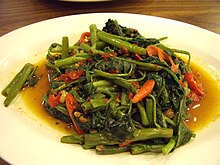

Vegetables play an important role in human nutrition. Most are low in fat and calories but are bulky and filling.[16] They supply dietary fibre and are important sources of essential vitamins, minerals and trace elements. Particularly important are the antioxidant vitamins A, C and E. When vegetables are included in the diet, there is found to be a reduction in the incidence of cancer, stroke, cardiovascular disease and other chronic ailments.[17][18] Research has shown that, compared with individuals who eat less than three servings of fruits and vegetables each day, those that eat more than five servings have an approximately twenty percent lower risk of developing coronary heart disease or stroke.[19]
Vegetables are eaten in a variety of ways, as part of main meals and as snacks. The nutritional content of vegetables varies considerably, though generally they contain little protein or fat,[20] and varying proportions of vitamins such as Vitamin A, Vitamin K and Vitamin B6, provitamins, dietary minerals and carbohydrates. Vegetables contain a great variety of other phytochemicals (bioactive non-nutrient plant compounds), some of which have been claimed to have antioxidant, antibacterial, antifungal, antiviral and anticarcinogenic properties.[21][22]
However, vegetables often also contain toxins and antinutrients which interfere with the absorption of nutrients. These include -solanine, -chaconine,[23]enzyme inhibitors (of cholinesterase, protease, amylase, etc.), cyanide and cyanide precursors, oxalic acid and others.[24] These toxins are natural defenses, used to ward off the insects, predators and fungi that might attack the plant. Some beans contain phytohaemagglutinin, and cassava roots contain cyanogenic glycoside as do bamboo shoots. These toxins can be deactivated by adequate cooking. Green potatoes contain glycoalkaloids and should be avoided.[25]
Vegetables and fruit, particularly leafy vegetables, have been implicated in nearly half the gastrointestinal infections caused by norovirus in the United States. These foods are commonly eaten raw and may become contaminated during their preparation by an infected food handler. Hygiene is important when handling foods to be eaten raw, and such products need to be properly cleaned, handled and stored to limit contamination.[26]
Dietary recommendations
The USDA Dietary Guidelines for Americans recommends consuming five to nine servings of fruit and vegetables daily.[27] The total amount consumed will vary according to age and gender, and is determined based upon the standard portion sizes typically consumed, as well as general nutritional content. Potatoes are not included in the count as they are mainly providers of starch. For most vegetables, one serving is equal to 1/2 cup and can be eaten raw or cooked. For leafy greens, such as lettuce and spinach, a single serving is typically a full cup. A variety of products should be chosen as no single fruit or vegetable provides all the nutrients needed for health.[19]
International dietary guidelines are similar to the ones established by the USDA. Japan, for example, recommends the consumption of five to six servings of vegetables daily.[28] French recommendations provide similar guidelines and set the daily goal at five servings.[29] In India, the daily recommendation for adults is 275 grams (9.7 oz) of vegetables per day.[17]
Cultivation
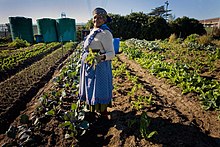
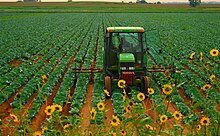
Vegetables have been part of the human diet from time immemorial. Some are staple foods but most are accessory foodstuffs, adding variety to meals with their unique flavours and at the same time, adding nutrients necessary for health. Some vegetables are perennials but most are annuals and biennials, usually harvested within a year of sowing or planting. Whatever system is used for growing crops, cultivation follows a similar pattern; preparation of the soil by loosening it, removing or burying weeds and adding organic manures or fertilisers; sowing seeds or planting young plants; tending the crop while it grows to reduce weed competition, control pests and provide sufficient water; harvesting the crop when it is ready; sorting, storing and marketing the crop or eating it fresh from the ground.[30]
Different soil types suit different crops, but in general in temperate climates, sandy soils dry out fast but warm up quickly in the spring and are suitable for early crops, while heavy clays retain moisture better and are more suitable for late season crops. The growing season can be lengthened by the use of fleece, cloches, plastic mulch, polytunnels and greenhouses.[30] In hotter regions, the production of vegetables is constrained by the climate, especially the pattern of rainfall, while in temperate zones, it is constrained by the temperature and day length.
On a domestic scale, the spade, fork and hoe are the tools of choice while on commercial farms a range of mechanical equipment is available. Besides tractors, these include ploughs, harrows, drills, transplanters, cultivators, irrigation equipment and harvesters. New techniques are changing the cultivation procedures involved in growing vegetables with computer monitoring systems, GPS locators and self-steer programmes for driverless machines giving economic benefits.[31]
Harvesting
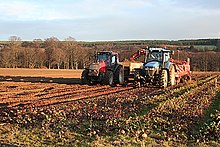
When a vegetable is harvested, it is cut off from its source of water and nourishment. It continues to transpire and loses moisture as it does so, a process most noticeable in the wilting of green leafy crops. Harvesting root vegetables when they are fully mature improves their storage life, but alternatively, these root crops can be left in the ground and harvested over an extended period. The harvesting process should seek to minimise damage and bruising to the crop. Onions and garlic can be dried for a few days in the field and root crops such as potatoes benefit from a short maturation period in warm moist surroundings during which time wounds heal and the skin thickens up and hardens. Before marketing or storage, grading needs to be done to remove damaged goods and select produce according to its quality, size, ripeness and colour.[32]
Storage
All vegetables benefit from proper post harvest care. A large proportion of vegetables and perishable foods are lost after harvest during the storage period. These losses may be as high as thirty to fifty percent in developing countries where adequate cold storage facilities are not available. The main causes of loss include spoilage caused by moisture, moulds, micro-organisms and vermin.[33]
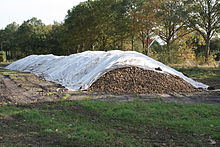
Storage can be short term or long term. Most vegetables are perishable and short term storage for a few days provides flexibility in marketing. During storage, leafy vegetables lose moisture, and the vitamin C in them degrades rapidly. A few products such as potatoes and onions have better keeping qualities and can be sold when higher prices may be available, and by extending the marketing season, a greater total volume of crop can be sold. If refrigerated storage is not available, the priority for most crops is to store high-quality produce, to maintain a high humidity level and to keep the produce in the shade.[32]
Proper post-harvest storage aimed at extending and ensuring shelf life is best effected by efficient cold chain application.[34] Cold storage is particularly useful for vegetables such as cauliflower, eggplant, lettuce, radish, spinach, potatoes and tomatoes, the optimum temperature depending on the type of produce. There are temperature controlling technologies that do not require the use of electricity such as evaporative cooling.[5] Storage of fruit and vegetables in controlled atmospheres with high levels of carbon dioxide or high oxygen levels can inhibit microbial growth and extend storage life.[35]
The irradiation of vegetables and other agricultural produce by ionizing radiation can be used to preserve it from both microbial infection and insect damage, as well as from physical deterioration. It can extend the storage life of food without noticeably changing its properties.[36]
Preservation
The objective of preserving vegetables is to extend their availability for consumption or marketing purposes. The aim is to harvest the food at its maximum state of palatability and nutritional value, and preserve these qualities for an extended period. The main causes of deterioration in vegetables after they are gathered are the actions of naturally-occurring enzymes and the spoilage caused by micro-organisms.[37] Canning and freezing are the most commonly used techniques, and vegetables preserved by these methods are generally similar in nutritional value to comparable fresh products with regards to carotenoids, vitamin E, minerals and dietary fibre.[38]
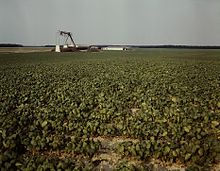
Canning is a process during which the enzymes in vegetables are deactivated and the micro-organisms present killed by heat. The sealed can excludes air from the foodstuff to prevent subsequent deterioration. The lowest necessary heat and the minimum processing time are used in order to prevent the mechanical breakdown of the product and to preserve the flavour as far as is possible. The can is then able to be stored at ambient temperatures for a long period.[37]
Freezing vegetables and maintaining their temperature at below 10 °C (14 °F) will prevent their spoilage for a short period whereas a temperature of 18 °C (0 °F) is required for longer-term storage. The enzyme action will merely be inhibited, and blanching of suitably sized prepared vegetables before freezing mitigates this and prevents off-flavours developing. Not all micro-organisms will be killed at these temperatures and after thawing the vegetables should be used promptly because any microbes present may proliferate more quickly than on fresh produce.[39]

Traditionally, sun drying has been used for some products such as tomatoes, mushrooms and beans, spreading the produce on racks and turning the crop at intervals. This method suffers from several disadvantages including lack of control over drying rates, spoilage when drying is slow, contamination by dirt, wetting by rain and attack by rodents, birds and insects. These disadvantages can be alleviated by using solar powered driers.[33] The dried produce must be prevented from reabsorbing moisture during storage.[37]
Both high levels of sugar and high levels of salt can preserve food by preventing micro-organisms from growing. Green beans can be salted by layering the pods with salt, but this method of preservation is unsuited to most vegetables. Marrows, beetroot, carrot and some other vegetables can be boiled with sugar to create jams.[37]Vinegar is widely used in food preservation; a sufficient concentration of acetic acid prevents the development of destructive micro-organisms, a fact made use of in the preparation of pickles, chutneys and relishes.[37]Fermentation is another method of preserving vegetables for later use. Sauerkraut is made from chopped cabbage and relies on lactic acid bacteria which produce compounds that are inhibitory to the growth of other micro-organisms.[5]
Top vegetable producers and their productivity

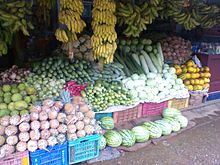
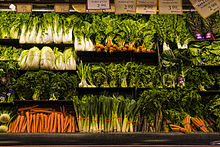
In 2010, China was the largest vegetable producing nation with over half the world's production. India, the United States, Turkey, Iran and Egypt were the next largest producers. China had the highest area of land devoted to vegetable production while the highist average yields were obtained in Spain and the Republic of Korea.[40]
| Country | Area cultivated thousand hectares | Yield thousand hg/ha | Production thousand tonnes |
|---|---|---|---|
| China | 23,458 | 230 | 539,993 |
| India | 7,256 | 138 | 100,045 |
| USA | 1,120 | 318 | 35,609 |
| Turkey | 1,090 | 238 | 25,901 |
| Iran | 767 | 261 | 19,995 |
| Egypt | 755 | 251 | 19,487 |
| Italy | 537 | 265 | 14,201 |
| Russian Federation | 759 | 175 | 13,283 |
| Spain | 348 | 364 | 12,679 |
| Mexico | 681 | 184 | 12,515 |
| Nigeria | 1844 | 64 | 11,830 |
| Brazil | 500 | 225 | 11,233 |
| Japan | 407 | 264 | 10,746 |
| Indonesia | 1082 | 90 | 9,780 |
| Republic of Korea | 268 | 364 | 9,757 |
| Vietnam | 818 | 110 | 8,976 |
| Ukraine | 551 | 162 | 8,911 |
| Uzbekistan | 220 | 342 | 7,529 |
| Philippines | 718 | 88 | 6,299 |
| France | 245 | 227 | 5,572 |
| Total world | 55,598 | 188 | 1,044,380 |
Standards
The International Organization for Standardization (ISO) sets international standards to ensure that products and services are safe, reliable and of good quality. There are a number of ISO standards regarding fruits and vegetables.[41] ISO 1991-1:1982 lists the botanical names of sixty-one species of plants used as vegetables along with the common names of the vegetables in English, French and Russian.[42] ISO 67.080.20 covers the storage and transport of vegetables and their derived products.[43]
See also
- Food quality
- Food safety
- Herbivore
- List of foods
- List of vegetable dishes
- List of vegetables
- Market gardening
- Perennial vegetable
- Plant pathology
- Post-harvest losses
- Veganism
- Vegetable carving
- Vegetarianism
References
- ^ a b c d Harper, Douglas. "vegetable". Online Etymology Dictionary.
- ^ a b Swedenborg, Emanuel (2003). Swedenborg Concordance 1888. Kessinger Publishing. p. 502. ISBN 0-7661-3728-7.
- ^ Ayto, John (1993). Dictionary of Word Origins. New York: Arcade Publishing. ISBN 1-55970-214-1. OCLC 33022699.
- ^ a b "Vegetable". Dictionary.com. Retrieved 2015-03-03.
- ^ a b c Sinha, Nirmal; Hui, Y.H.; Evranuz, E. Özgül; Siddiq, Muhammad; Ahmed, Jasim (2010). Handbook of Vegetables and Vegetable Processing. John Wiley & Sons. p. 192, 352. ISBN 978-0-470-95844-5.
- ^ Vainio, Harri and Bianchini, Franca (2003). Fruits And Vegetables. IARC. p. 2. ISBN 9283230086.
- ^ "Fungi vegetables". Spices & Medicinal Herbs: Classification of vegetables. Retrieved 2015-03-24.
- ^ NIX v. HEDDEN, 149 U.S. 304 (1893). Findlaw.com.
- ^ Portera, Claire C.; Marlowe, Frank W. (January 2007). "How marginal are forager habitats?". Journal of Archaeological Science 34 (1): 5968. doi:10.1016/j.jas.2006.03.014.
- ^ Douglas John McConnell (1992). The forest-garden farms of Kandy, Sri Lanka. p. 1. ISBN 978-92-5-102898-8.
- ^ "The Development of Agriculture". National Geographic. Retrieved 2015-03-05.
- ^ Wharton, Clifton R. (1970). Subsistence Agriculture and Economic Development. Transaction Publishers. p. 18. ISBN 978-0-202-36935-8.
- ^ a b Lambert, Tim. "A brief history of Food". Retrieved 2015-03-04.
- ^ Apel, Melanie Ann (2004). Land and Resources in Ancient Greece. Rosen Publishing Group. p. 10. ISBN 978-0-8239-6769-8.
- ^ Forbes, Robert James (1965). Studies in Ancient Technology. Brill Archive. p. 99.
- ^ "Fruits and vegetables". Nutrition for everyone. Centers for Disease Control and Prevention. Retrieved 2015-03-30.
- ^ a b "Vegetables". Infotech Portal. Kerala Agricultural University. Retrieved 2015-03-24.
- ^ Terry, Leon (2011). Health-Promoting Properties of Fruits and Vegetables. CABI. pp. 24. ISBN 978-1-84593-529-0.
- ^ a b "Vegetables and Fruits: Get Plenty Every Day". Harvard School of Public Health. Retrieved 2015-03-30.
- ^ Whitaker, Julian M. (2001). Reversing Diabetes. New York: Warner Books. ISBN 0-446-67658-6. OCLC 45058465.
- ^ Gruda, N. (2005). "Impact of environmental factors on product quality of greenhouse vegetables for fresh consumption". Critical Reviews in Plant Sciences 24 (3): 227247. doi:10.1080/07352680591008628.
- ^ Steinmetz, K. A.; Potter, J. D. (1996). "Vegetables, fruit, and cancer prevention: a review". Journal of the American Dietary Association 96 (10): 10271039. doi:10.1016/S0002-8223(96)00273-8. PMID 8841165.
- ^ Finotti, Enrico; Bertone, Aldo; Vivanti, Vittorio (2006). "Balance between nutrients and anti-nutrients in nine Italian potato cultivars". Food Chemistry 99 (4): 698. doi:10.1016/j.foodchem.2005.08.046.
- ^ "Foodborne Pathogenic Microorganisms and Natural Toxins Handbook". Bad Bug Book (Second edition). U.S. Food and Drug Administration. 2013. Retrieved 2015-03-30.
- ^ "Naturally Occurring Toxins in Vegetables and Fruits". Risk Assessment in Food Safety. Centre for Food Safety. 2015-02-18. Retrieved 2015-03-30.
- ^ Centers for Disease Control and Prevention (2013). "Attribution of Foodborne Illness, 1998-2008". Estimates of Foodborne Illness in the United States 19 (3).
- ^ Fabulous fruits... versatile vegetables. United States Department of Agriculture. Retrieved 2012-03-30.
- ^ The Japanese Diet. the-food-guide-pyramid.com
- ^ The French Dietary Guide. the-food-guide-pyramid.com
- ^ a b Brickell, Christopher (ed) (1992). The Royal Horticultural Society Encyclopedia of Gardening (Print). Dorling Kindersley. pp. 303308. ISBN 978-0-86318-979-1.
- ^ Harry Field, Harry; Solie, John (2007). Introduction to Agricultural Engineering Technology: A Problem Solving Approach. Springer Science & Business Media. ISBN 978-0-387-36915-0.
- ^ a b Dixie, Grahame (2005). "8. Post-harvest handling: Storage". Horticultural Marketing. FAO. Retrieved 2015-03-21.
- ^ a b Garg & Prakash; Garg, H.P. (2000). Solar Energy: Fundamentals and Applications. Tata McGraw-Hill Education. p. 191. ISBN 978-0-07-463631-2.
- ^ Kohli, Pawanexh (2008) "Why Cold Chain for Vegetables" in Fruits and Vegetables Post-Harvest Care: The Basics. Crosstree Techno-visors
- ^ Thompson, A. Keith (2010). Controlled Atmosphere Storage of Fruits and Vegetables. CABI. p. 18. ISBN 978-1-84593-647-1.
- ^ de Zeeuw, Dick. "Use of nuclear energy to preserve man's food". International Atomic Energy Agency. Retrieved 2015-03-22.
- ^ a b c d e Home preservation of Fruit and Vegetables. Ministry of Agriculture, Fisheries and Food. 1968. pp. 16.
- ^ Rickman, Joy C. ; Bruhn, Christine M.; Barrett, Diane M. (2007). "Nutritional comparison of fresh, frozen, and canned fruits and vegetables II. Vitamin A and carotenoids, vitamin E, minerals and fiber". Journal of the Science of Food and Agriculture 87 (7): 11851196. doi:10.1002/jsfa.2824.
- ^ Van Arsdel, W. B.; Copley, M. J.; Olson, R. L. (1969). Quality and stability of frozen foods.
- ^ "Table 27 Top vegetable producers and their productivity". FAO statistics. Food and Agriculture Organization of the United Nations. Retrieved 2015-03-20.
- ^ "67.080: Fruits. Vegetables". International Organization for Standardization. Retrieved 2009-04-23.
- ^ "ISO 1991-1:1982: Vegetables -- Nomenclature". International Organization for Standardization. Retrieved 2015-03-20.
- ^ "67.080.20: Vegetables and derived products". International Organization for Standardization. Retrieved 2015-03-20.
External links
Wikibooks Cookbook has a recipe/module on
|
| Wikimedia Commons has media related to Vegetable. |
- Photo ID of Vegetables by Capt. Pawanexh Kohli
- Vegetables
Defining a "vegetable" is hard because so many different parts of a plant are consumed as food; roots, tubers, bulbs, corms, stems, leaf stems, leaf sheaths, leaves
Vegetable flannel - Wikipedia, the free encyclopedia
Vegetable flannel is a type of flannel using fibres from the Scots pine, or pinus sylvestris, rather than traditional woollen fibres. It is described as having a hemp
Vegetable - Simple English Wikipedia, the free encyclopedia
The word "vegetable" can also be used to mean plants in general, such as when people say " Animal, Vegetable, or Mineral."
Cruciferous vegetables - Wikipedia, the free encyclopedia
Cruciferous vegetables are vegetables of the family Brassicaceae (also called Cruciferae). These vegetables are widely cultivated, with many genera, species, and
Vegetable Wikipedia The Free Encyclopedia
Vegetable Wikipedia the free encyclopedia Vegetable Wikipedia the free encyclopedia Defining a "vegetable" is hard because so many different parts of a plant are
List of vegetables - Simple English Wikipedia, the free ...
Some vegetables which are botanically fruits (such as tomatoes) are considered to be vegetables in the culinary (eating) sense. This is why they appear in this article.
Vegetable Wikipedia The Free Encyclopedia Latest News
Vegetable Wikipedia The Free Encyclopedia article For the vegetable sometimes called yam in the united states, see sweet potato. for the vegetable called yam in new
Vegetable Wikipedia The Free Encyclopedia
Read Vegetable wikipedia, the free encyclopedia and download Vegetable Wikipedia The Free Encyclopedia, In everyday usage, a vegetable is an edible plant or its part
Vegetable Wikipedia The Free Encyclopedia | PDF Library
Vegetable Wikipedia The Free Encyclopedia. In this Vegetable Wikipedia The Free Encyclopedia ebook you can read all information in this pdf. in this ebook you will
Vegetable Wikipedia The Free Encyclopedia | Warta Gadget
Currently you are viewing the latest Vegetable Wikipedia The Free Encyclopedia headline and breaking news at Warta Gadget and reading more information about Vegetable
